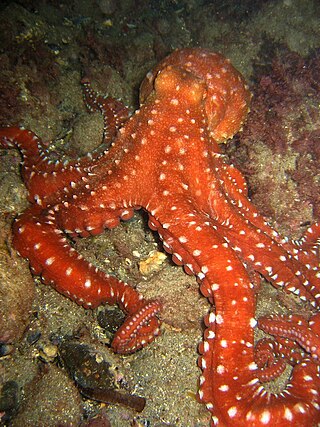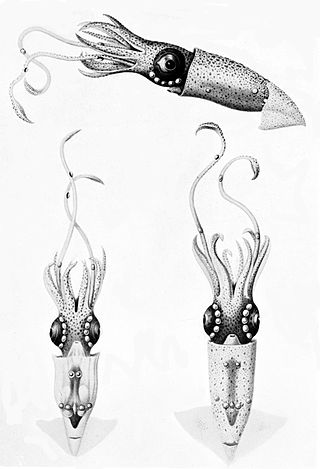
Herring are forage fish, mostly belonging to the family of Clupeidae.

Cichlids are fish from the family Cichlidae in the order Cichliformes. Traditionally Cichlids were classed in a suborder, the Labroidei, along with the wrasses (Labridae), in the order Perciformes, but molecular studies have contradicted this grouping. On the basis of fossil evidence, it first appeared in Argentina during the Early Eocene epoch, about 48.6 million years ago; however, molecular clock estimates have placed the family's origin as far back as 67 million years ago, during the late Cretaceous period. The closest living relative of cichlids is probably the convict blenny, and both families are classified in the 5th edition of Fishes of the World as the two families in the Cichliformes, part of the subseries Ovalentaria. This family is large, diverse, and widely dispersed. At least 1,650 species have been scientifically described, making it one of the largest vertebrate families. New species are discovered annually, and many species remain undescribed. The actual number of species is therefore unknown, with estimates varying between 2,000 and 3,000.

The brook lamprey, also known as the European brook lamprey and the western brook lamprey is a small European lamprey species that exclusively inhabits freshwater environments. The species is related to, but distinct from, the North American western brook lamprey.

The Banggai cardinalfish is a small tropical cardinalfish in the family Apogonidae. It is the only member of its genus. This attractive fish is popular in the aquarium trade. It is among the relatively few marine fish to have been bred regularly in captivity, but significant numbers are still captured in the wild and it is now an endangered species. The detrimental impact of humans on its environment and certain fatal diseases threaten this species' numbers significantly. Iridovirus diseases are known to be significant reason for fish mortality.

Amatitlania sajica, the T-bar cichlid or Sajica cichlid, is a Central American species of cichlid found in freshwater streams and lakes on the Pacific slope of Costa Rica. The fish is tan colored with seven indistinct bars on the body. The third bar is usually prominent and coupled with a dark lateral stripe running from the gill cover results in a horizontal T-shaped mark, hence the common name of T-bar cichlid.

The seamoths make up a family of ray-finned fishes, the Pegasidae, within the order Syngnathiformes. They are named for Pegasus, a creature from Greek mythology. Seamoths are notable for their unusual appearance, including flattened bodies, the presence of large, wing-like, pectoral fins, a long snout, and a body encased in thick, bony plates. They are found primarily in coastal tropical waters of the Indo-Pacific.

The northern brook lamprey is a freshwater fish in the family Petromyzontidae. It is closely related to the silver lamprey and may represent an ecotype of a single species with I. unicuspis.

The Kessler's gudgeon is a European species of freshwater fish in the family Cyprinidae. It is found in the Danube and Vistula drainage basins, including parts of Poland, Austria, the Czech Republic, Ukraine, Bulgaria, Romania, Moldova, Hungary, Croatia, Bosnia and Herzegovina, Serbia, Montenegro, Slovakia, and Slovenia. It is a small fish of no economic or sporting importance. It was at one time classified as Gobio kessleri.

The stone loach is a European species of fresh water ray-finned fish in the family Nemacheilidae. It is one of nineteen species in the genus Barbatula. Stone loaches live amongst the gravel and stones of fast flowing water where they can search for food. The most distinctive feature of this small fish is the presence of barbels around the bottom jaw, which they use to detect their invertebrate prey. The body is a mixture of brown, green and yellow.
Zhangixalus omeimontis is a species of frog in the family Rhacophoridae endemic to China. Its common name is Omei whipping frog or Omei treefrog, in reference to its type locality, Mount Emei (Chinese: 峨嵋山; pinyin: Éméi Shān; Wade–Giles: O2-mei2 Shan1) in Sichuan. It is found in southern and central China in Yunnan, Sichuan, Guangxi, Guizhou, Hunan, and Hubei provinces. It has been observed between 200 and 700 meters above sea level. It is a relatively common frog that inhabits forests, and sometimes farmland. It breeds in still water (pools and ponds). Agriculture and logging are threats to this species.

The Hawaiian sea-moth fish is a species of ray-finned fish in the family Pegasidae. It is endemic to Hawaii. The only other species in the genus is Eurypegasus draconis.

The brick seamoth, Pegasus laternarius, also known as the long-tailed dragonfish, long-tailed seamoth, pelagic dragon-fish, or the winged dragonfish, is a species of ray-finned fish in the Pegasidae, or seamoth, family. This species is used extensively in the Guangdong and Guangxi province of China to treat scrofula, cough, and diarrhea.

The longtail seamoth is a species of ray-finned fish in the family Pegasidae. It is found around the coasts of Australia, Bahrain, China, India, Indonesia, Malaysia, Mozambique, Myanmar, the Philippines, Saudi Arabia, Singapore, Taiwan, Tanzania, and Thailand. This fish is used in Chinese medicine and in the aquarium trade.

The pindu is a critically endangered species of cichlid endemic to Lake Barombi Mbo in western Cameroon.

Spawn is the eggs and sperm released or deposited into water by aquatic animals. As a verb, to spawn refers to the process of freely releasing eggs and sperm into a body of water ; the physical act is known as spawning. The vast majority of aquatic and amphibious animals reproduce through spawning. These include the following groups:

Callistoctopus macropus, also known as the Atlantic white-spotted octopus, white-spotted octopus, grass octopus or grass scuttle, is a species of octopus found in shallow areas of the Mediterranean Sea, the warmer parts of the eastern and western Atlantic Ocean, the Caribbean Sea, and the Indo-Pacific region. This octopus feeds on small organisms which lurk among the branches of corals.
Synodontis camelopardalis, known as the giraffe synodontis, is a species of upside-down catfish that is endemic to the Democratic Republic of the Congo where it is only known to occur in the Tshuapa River. It was first described by Max Poll in 1971. The original specimens were obtained in Eala, on the Ruki River in the central Congo River Basin. The species name camelopardalis refers to the giraffe, Giraffa camelopardalis, in reference to the coloration of the fish.
Synodontis unicolor is a species of upside-down catfish that is endemic to the Democratic Republic of the Congo where it occurs in the area of Luapula-Mweru. It was first described by George Albert Boulenger in 1915. The original specimens were obtained in Kasenga, on the Luapula River in what is now the Democratic Republic of the Congo. The species name unicolor means "one color", referring to the uniform dark-brown coloration on the body and fins.

Lycoteuthis lorigera is a species of squid in the genus Lycoteuthis. They grow up to 8 cm (3.1 in) in length.

Pegasus is a genus of seamoths found in coastal tropical marine waters. The name was taken from the winged horse Pegasus in Greek mythology. This horse was created with Medusa´s blood. The member species are distributed in the Indo-West Pacific Ocean waters around: Australia, Bahrain, China, India, Indonesia, Japan, Malaysia, Mozambique, Myanmar, the Philippines, Saudi Arabia, Singapore, Taiwan, Tanzania and Thailand.




















